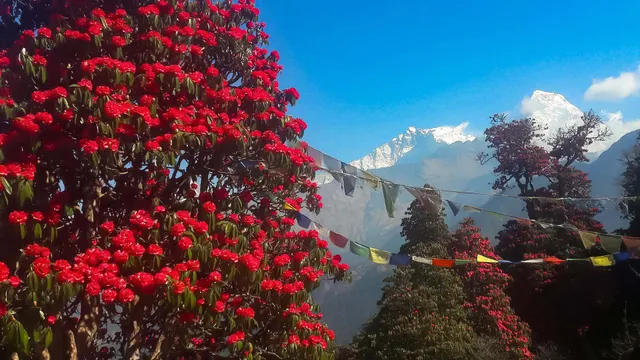Rhododendron- Physical Character, Habitat, Pollination and challenges
The Rhododendron: A Beautiful and Resilient Flower
Rhododendrons are among the most striking and colorful plants in the world. Known for their beautiful blooms and variety of species, they have captured the attention of gardeners, nature lovers, and botanists alike. Found in a variety of habitats across the globe, rhododendrons thrive in environments ranging from temperate forests to alpine regions. In this essay, we will explore what makes the rhododendron so unique, its characteristics, habitat, cultural significance, and the challenges it faces.
Physical Characteristics
Rhododendrons are a type of flowering shrub or small tree that belongs to the genus Rhododendron, which is part of the heath family, Ericaceae. There are over 1,000 species of rhododendrons, and they can range in size from tiny ground covers to large shrubs or even small trees. The most distinctive feature of these plants is their vibrant and colorful flowers, which can come in many shades, including red, pink, purple, white, and yellow. These flowers often have five petals and are typically grouped together in large, dense clusters, making them even more eye-catching.
In addition to their flowers, rhododendrons have glossy, leathery leaves that are usually dark green. Some species have evergreen leaves, meaning they stay green throughout the year, while others are deciduous and lose their leaves in the winter. The leaves of evergreen rhododendrons can often withstand cold temperatures, which helps them survive in harsher climates.
The size of rhododendrons varies depending on the species. Some can grow up to 20 feet tall, while others stay small and compact. In general, rhododendrons have a dense, bushy growth habit, with branches spreading outwards from a central stem.
Habitat and Distribution
Rhododendrons are native to many parts of the world, including Asia, Europe, North America, and even parts of the Pacific Islands. The highest diversity of rhododendron species is found in the Himalayan region of Asia, where some species grow at altitudes of over 15,000 feet. In North America, they are commonly found in the eastern United States, especially in the Appalachian Mountains, as well as parts of the Pacific Northwest.
Rhododendrons generally thrive in areas with cool, moist climates. They are often found in temperate regions, where the weather is mild and the soil is acidic and well-drained. These plants grow best in locations with partial shade, as they are sensitive to direct sunlight, which can scorch their delicate leaves. They are commonly found in woodlands, along mountain slopes, and near streams or rivers, where the soil remains consistently moist.
In alpine regions, rhododendrons can be seen growing at high altitudes, where they are exposed to harsh conditions, such as low temperatures and strong winds. Despite these challenges, they are able to survive by growing low to the ground and forming dense, compact clusters that protect them from the elements.
Rhododendron Flowers and Pollination
The flowers of rhododendrons are not only beautiful but also serve an important role in attracting pollinators. Bees, butterflies, and hummingbirds are often drawn to the bright, fragrant flowers, where they collect nectar and pollen. In return, they help pollinate the flowers, allowing the plants to reproduce and produce seeds.
Rhododendron flowers are typically large and showy, which makes them highly attractive to pollinators. The flowers also release a sweet fragrance that adds to their appeal. Each flower contains both male and female reproductive organs, which allows them to self-pollinate, although cross-pollination with other plants often leads to better genetic diversity.
The flowering season for rhododendrons varies by species, but many bloom in the spring or early summer, filling gardens and forests with vibrant colors. Some species, especially the ones found in colder regions, bloom later in the year, often in late summer or fall.
Cultural Significance
Rhododendrons have been admired for centuries for their beauty and resilience. They have become symbols of various meanings in different cultures. In some parts of the world, they are considered a symbol of peace and tranquility, while in others, they represent strength and endurance due to their ability to thrive in harsh climates.
In Asia, particularly in countries like Japan and China, rhododendrons hold cultural significance. In Japan, for example, the plant is associated with the concept of purity, and it is often featured in traditional art and poetry. Rhododendrons are also important in the context of Buddhism, where they are thought to symbolize spiritual enlightenment.
In the United States, rhododendrons are a popular ornamental plant in gardens and landscapes. They are often used to add color and variety to outdoor spaces, particularly in shady areas. The state flower of West Virginia is the Rhododendron maximum, or the great rhododendron, which is native to the region.
Challenges Faced by Rhododendrons
While rhododendrons are resilient plants, they do face some challenges, particularly in the face of climate change. Rising temperatures and changing weather patterns are affecting the habitats where rhododendrons grow. Warmer temperatures may cause the plants to bloom too early, leading to damage from late frosts, or they may reduce the amount of moisture available in the soil, making it harder for the plants to thrive.
Another threat to rhododendrons is pollution. As urban areas expand, rhododendrons that grow in nearby woodlands or natural habitats may be affected by air and soil pollution, which can impact their health and ability to reproduce. Additionally, invasive species, such as certain pests and diseases, can threaten rhododendron populations by damaging their leaves and flowers.
Conclusion
The rhododendron is a beautiful and resilient plant that adds color and life to landscapes around the world. Its vibrant flowers, adaptability to various environments, and cultural significance make it a plant worth appreciating. However, like many other species, rhododendrons face challenges from environmental changes and human activity. It is important for people to recognize the beauty of these plants and take steps to protect them and their natural habitats, ensuring that future generations can enjoy the breathtaking sight of rhododendrons in bloom.
Read also:



Comments
Post a Comment